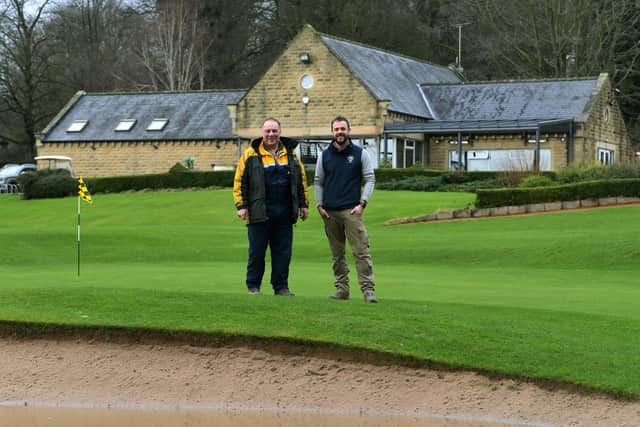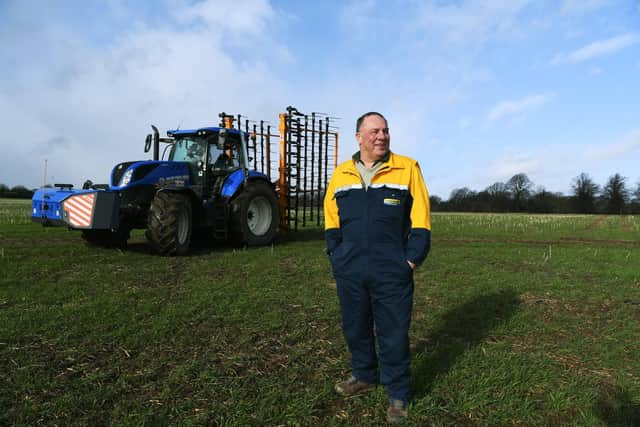Farm of the Week: Pig farmers who built Woolley Park Golf Club on their land
Phil Rowbottom has an arable acreage of 330 acres with the remaining 170 of what was a 500-acre arable farm in 1992 devoted to the family concern that is Woolley Park Golf Club incorporating 18-hole and nine-hole courses.
Phil said Mount Farm has been a totally arable farm since he and his late father David came out of pigs in the 80s and it was his father who surprised him with his golf announcement.
Advertisement
Hide AdAdvertisement
Hide Ad“Father came in for coffee one morning and just said we ought to build a golf course. We didn’t know where he’d got the thought, none of us played. It seemed a ridiculous statement on what seemed the spur of the moment.


“We built an 18-hole course and a modest clubhouse, but then realised the value in building a nine-hole course for those who couldn’t devote the time to what is often a four-hour round plus perhaps a little time at the bar afterwards.”
While Phil does play a little, he said he’s still very much the farmer he always wanted to be and that his father and grandfather were too.
“I knew I was going to be a farmer from a very early age and although my father leaned on me a little to learn a trade it was never going to happen. I studied agriculture at Shuttleworth College in Bedfordshire and began farming when I returned in 1982.


Advertisement
Hide AdAdvertisement
Hide Ad“My grandfather Ralph came here on a tenancy from Helmsley in 1927 and during the Second World War he got the job of farming Woolley Park, next door, as part of the War Agricultural commission, to turn it into productive land. He bought Mount Farm in 1949 and Woolley Park’s land in the 1970s having tenanted it. My father and uncle used to farm together and at one time had another farm in the next village that took us to 650 acres but went their separate ways in the early 80s.
“We had 250 sows and we were dealing with everything from breeding to bacon. Dad had brought the pig unit onto the farm when he’d left school. Our farm logo still has a pig in a gate. My grandfather had sheep and cattle.”
Grain has been Phil’s primary source of income from the land throughout his agricultural career, but he has more than one string to his grain bow as he operates a grain storage facility on the farm and has utilised his recent move into the direct drilling market to good effect for neighbours’ farms.
Phil said he keeps his growing system very simple.
“I just grow on a rotation of two wheats and a rape crop, that’s it across the whole 330 acres. I’ve grown milling wheat all my farming career. That’s my father’s legacy.
Advertisement
Hide AdAdvertisement
Hide Ad“We’re on what I call boy’s land, sandstone, pretty average Grade 3 land with a lot of stone in it that is too wet to drill one day and too dry the next. It’s weird but easy land and we can always establish a good wheat crop. I’ve never failed to get drilled up each autumn even though some may have been drilled fairly late.”
Phil said his yields where a welcome surprise last year.
“Last year’s harvest was a good year for our wheats overall. Skyfall achieved 3.6 to 3.7 tonnes per acre, but Skyscraper went over four tonnes per acre which is exceptional for us. We normally average around 3.5 for our wheats. We drilled the feed wheat from the middle to the end of October as late drilled milling wheat doesn’t work here.
"I haven’t had yields like that for a long time. Our rape did 1.8 tonnes too, which is also unheard of for me. We traditionally struggle to get to 1.5 tonnes.
“I want to grow milling wheat because it is for human consumption but the premium isn’t enough. I don’t agree that milling wheat should be bought as feed wheat plus a bit for milling quality.
Advertisement
Hide AdAdvertisement
Hide Ad“But growing feed wheat at four tonnes an acre and with the price it has been achieving lately being very healthy I’ve gone for all my second wheat as feed wheat for this harvest.”
Phil said his latest on-farm developments have been plotted over the past three to four years having taken into account the various changes coming more broadly to agriculture.
“I’ve been watching the continuing BPS fiasco, the ELMS that my daughter Emma and I are busy complying with and will see me join an environmental scheme for the first time ever, and the Net Zero Challenge issued by the NFU.
“I can do Net Less, but not Net Zero, and we are now an SFI pilot farm which I don’t know whether will be good, bad or indifferent, but we are trying to fit with what is needed.”
Advertisement
Hide AdAdvertisement
Hide AdPhil said his most recent major change has not only benefited his soil but has also led to a new source of income that should offset his loss of BPS income this year.
“I went min-till last year. I’ve put the farm in a place where I think the land has improved. Our wheat looks brilliant and I’ve saved on my diesel cost by a lot as a result.”
Phil said grain storage is his other farm earner. “When we built a new farmstead here at Mount in the early 80s we built a storage facility that had greater capacity than we needed. We have been storing other farmers’ grain for 40 years and store for up to 20 farmers.”
Phil said there is also another source of income through the golf enterprise, plus another sporting side to the overall business and an annual event that means he is not 100 per cent min-till.
Advertisement
Hide AdAdvertisement
Hide Ad“We rent machines we use on our courses to others, such as green aeration equipment; we run a clay pigeon shoot, which is my sport; and we host the annual Great Barugh & District Ploughing Match."
Phil said every member of the family clubs together “My wife Jane runs the entire office, Emma runs the payroll and more besides, my son John runs the keeping of the courses, his wife Emily runs the golf club and our son-in-law Jonathan Guy is our crop specialist.”
